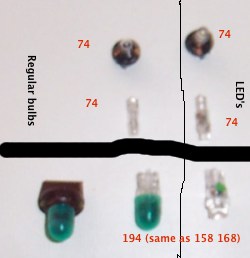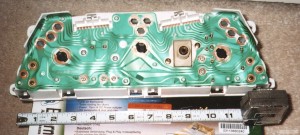If you’re simply looking for raw data (numbers), skip to the bottom of this write-up. Otherwise, continue on for some background and other info.
In my previous LED writeup, I found that LED bulbs when used in a vehicle happen to use much less power than regular bulbs. In my own case, replacing the front side-markers, rear side-markers, and rear park lights (essentially, all the lights that come on with the headlights with the exception of the headlights themselves), the current draw was brought down from 2.14 amps to about 0.26 amps. This means that the LED’s used about 12% of the power. Not bad.
Next, it was time to replace the bulbs in the instrument cluster. This includes the illumination lights (the ones that light up the cluster so you can see it at night), the signals, and the idiot lights (brake light, check engine light, seat belt light, etc). It just so happened that I was swapping out my instrument cluster anyway, so I ordered some LED’s from V-LED’s (my other eBay favorite “HyperLED’s” didn’t carry them), and away I went…
First, a little physical comparison:
In the event you can make anything out from that poor picture, the led’s are basically on the right hand side, with their regular counterparts on the left. Top section are the tiny “74” bulbs used for the idiot lights, signals, etc. Bottom section is the larger “158” bulbs which are the ones that illuminate the cluster when your lights are on. From now on, i’ll just call them “tiny” and “large”. The black plastic plug/socket for the tiny bulbs actually encompasses part of the bulb itself. Since the tiny led’s were a bit fatter than the original glass bulbs, the plastic socket had to bend out a bit for them to fit. It wasn’t that hard – a simply matter of forcing the bulb in, but it since the socket was now flexed out a bit, it also had to be forced into the instrument cluster holes when replacing them into the cluster with the new bulbs.
Here’s a shot of the back of the original instrument panel (’91 Chev Sprint):
You’ll see that there are 9 tiny bulbs and 2 large ones. There’s also an empty slot for another tiny bulb.
The instrument cluster I was replacing it with was from an ’89 Turbo. The layout is drastically different, although it was still plug ‘n’ play. The Turbo cluster also has a tach. Unfortunately I didn’t grab a picture of it, but it looks almost identical to this one (taken from the teamswift.net website).
Click on the image to see the full size version. The major differences between this pic and the turbo cluster I received are that the turbo cluster has a bulb in the bottom-center for the turbo light, and the ’89 turbo cluster also lacked the bulb for the DRL.
Setup
Here’s where the fun begins. Aside from having to “force” the slightly larger tiny bulbs into the sockets (and then force the sockets into the cluster), it was a simple matter of swapping the bulbs, installing the cluster, checking to see which idiot lights didn’t light up (remember, LED’s only work one way), removing the cluster again, reversing the bulbs that didn’t light up, then plugging it all back in. One oddity that resulted (could be an issue with the new cluster, but quite possibly the result of using LED’s) was that when the lights are off, when I hit the brakes, the illumination lights come on very slightly. It’s not enough to be noticable during the day, but as it gets dark, it becomes apparant. It could be a bad ground somewhere, or the system could have been designed this way from the start. The low amount of current that passes through would probably never be enough to light up a regular bulb. Since LED’s don’t need very much current though, even a slight bit is enough to light them up. A possibility to ponder if you do try the replacement.
Numbers numbers numbers
These are based on the number of bulbs in the new instrument cluster with the tach.
Original bulbs:
- 3 x 158 (aka 168 194)
- 9 x 74
New bulbs:
- 3 x 158 (aka 168 194) inverted cone super green LED’s (seemed slightly dimmer than originals)
- 9 x 74 super white LED’s (seemed slightly brighter than originals)
Using an ammeter, I hooked up the bulbs to a 12 volt battery on a charger and checked the current:
| Regular Bulb | LED | |
| 158 (168/194) bulb | 0.22A | 0.02A |
| 74 bulb | 0.10A | 0.02A |
| Total current when headlights on (the 3 illumination lights) | 0.66A | 0.06A |
| Total current with all bulbs on | 1.56A | 0.24A |
The savings from the tiny 74 bulbs is pretty marginal. I think it’s safe to say that they’ll never pay for themselves, partly because the original bulbs don’t use much current to begin with, but mainly because they’re almost never on. Really, aside from starting the car (when all the idiot lights come on for that moment between turning the key to “on” and starting the car), the only time one of these will be on for an extended period of time will be if you have daytime running lights (DRL indicator always on), or if you do a lot of night-time driving with your brights on (brights indicator). Since you probably use your signals sometimes, you’d get a little bit of a savings there too I suppose, but nothing to get excited about.
Replacing the large 158/168/194 bulbs can be a little more worthwhile. They’re always on when your lights are on, and you can save a little over half an amp (0.6A).


